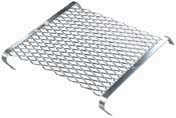Stucco is a traditional exterior building material noted for its durability, versatility, economy and ease
of application. Basically it is a mixture of cement and sand applied over wire lath or a masonry substrate such as concrete block or poured concrete. Problems associated with stucco are normally, too much sand was used in the mix making it very soft. Wire lath not applied properly and/or building movement causing cracking, and peeling and blistering of paint due to poor painting techniques or water intrusion.
Lets review some basic instructions for painting your stucco.
Tools and Equipment:
Ladders
Assorted paint brushes 2-4-inch
Canvas drop cloths, plastic tarps or newspapers
Spackle, caulking and elastomeric patch for patching holes and cracks
Small Bucket to "cut in" with
Painter's tape or masking tape
Putty knife
Sandpaper
Primer/sealer if required
Roller frame (with extension pole)
Roller cover 1/2" nap - 1" nap length
5 gallon bucket and a roller grid.
 A roller grid slips inside a 5 gallon pail for easy loading of a roller. Roller pans are a paint spill waiting for a place to happen. They fall off ladders, its too easy to step backwards and into them and children and pets cannot seem to avoid tipping them over.
A roller grid slips inside a 5 gallon pail for easy loading of a roller. Roller pans are a paint spill waiting for a place to happen. They fall off ladders, its too easy to step backwards and into them and children and pets cannot seem to avoid tipping them over.
Preparation:
Cleaning, Coatings require a clean, sound surface free from dust, chalk, mildew, grease, loose paint and other
contamination .The most common method of cleaning is pressure washing to remove chalk and loose and peeling paint. If mold or mildew is present use a cleaning solution of bleach and water (not recommended by us, bad for environment and dangerous), or use sodium percarbonate better known as oxygen bleach.
Remove light fixtures, shutters, house numbers, anything that can be easily removed, as you should paint in behind them.
Once clean we recommend a coat of surface sealer.
Chalk Locker is designed to penetrate the surface, seal it off and lock down any residual chalk that may be present. Using the sealer guarantees you that the finish paint will not peel. When you paint over a well sealed surface you get better sq footage out of your paint, the paint resins stay on top instead of being sucked into the stucco and your caulking and patching materials are applied to a clean sound surface insuring they will stay in place.
Caulk and Patch, Caulk around windows, doors, flashing, exterior light fixtures and anthing else that is attached to the walls. Fill cracks with an elastomeric patching compound. These are available in both smooth and textured finishes, and have tremendous adhesion and flexibility.
Large movement cracks and other serious problems, such as loose framing or wire lath, cannot be cured by patches and paint, so be sure to seek professional assistance if that is the case with your stucco.
Applying the finish Paint:
A quality acrylic latex paint formulated for stucco or an elastomeric are the coatings of choice. Acrylic
latex provides excellent protection unless some substrate
problems or the need to protect against wind-driven rain make
elastomeric a better choice. Elastomerics are gaining in popularity among owners because their heavier film build
and elasticity provide the highest degree of protection possible. Basically they are very thick, rubber like coatings that stretch and contract with the buildings movement. we recommend our Insul-Flex Elastomeric it not only waterproofs your home but also Insulates!
Pour all your paint into an empty 5 gallon pail and if you are using your own paint and the insulating ceramic additive mix it in slowly with a stick until well blended. A slight thickening of the paint will result from the addition of the additive and I recommend you thin it with at least a pint of water per gallon. You always want to intermix all your paint prior to starting any paint job with a tinted paint to insure the color is uniform all around the house. Paint tinting machines make small errors and this avoids any touchup problems.
Now pour 2" or so of your paint into a 1-2 gallon work bucket and do all your "cut in" work around doors, windows etc.
Select a roller cover for the surface you are painting, a smooth float finish stucco is best painted with a 1/2" - 3/4" roller cover, rough spanish style stucco may require a 1" - 1 1/2" thick roller cover. Spray painting is an option but I always recommend back rolling to work the paint in well. Spray an area and while still wet, run a roller over it.
When finished clean your tools, pick up debris, replace shutters etc and start enjoying your energy savings!
RELATED:
General Painting Tips
How to use a paint roller with No Mess
Tips on Spray Painting
Painting Interior Ceilings
Paint Interior Walls & Trim
Attics, Spray on a Radiant Barrier Coating
Insulating Roof Coating Application
Painting Roofs on RV's, Buses, Mobile Homes
Exterior Wood,Metal and Vinyl siding
Prices & Ordering Information
Why Wait? Buy Insulating House Paint, Use it,
Cut Those Utility Bills and Start Saving Now!
Safe, Non-Toxic, and Environmentally Friendly